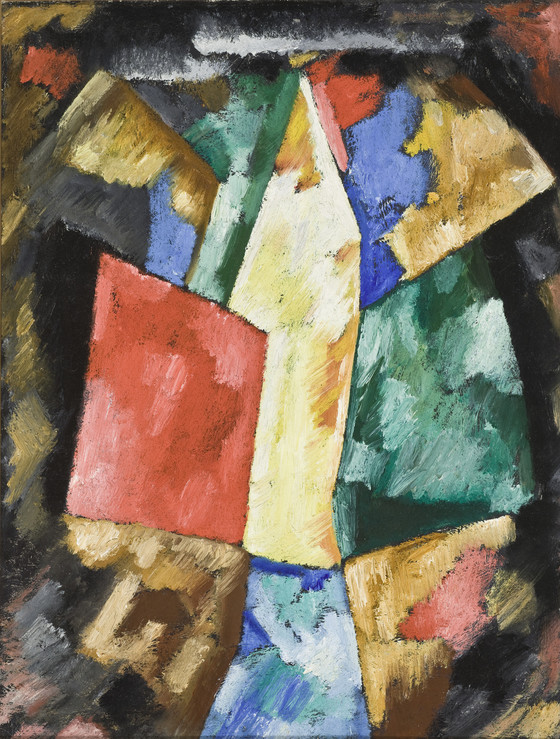During his first trip abroad Hartley felt closest to the German avant-garde, who shared with him a concern for the spiritual....
During his first trip abroad Hartley felt closest to the German avant-garde, who shared with him a concern for the spiritual. After having studied the newly published, illustrated almanac Der Blaue Reiter and Kandinsky’s theoretical treatise Über des Geistige in der Kumst, 1912 -- both of which he recommended to Stieglitz -- Hartley visited Kandinsky in January 1913. Contact with such a painter, as well as his recent reading of Henri Bergson and William James, made Hartley realize the value of abandoning the representation of objective reality in order to create a more abstract art. From May to November 1913 Hartley lived in Berlin, where he created several color abstractions that reveal the impact of Kandinsky more than any of his other works. Abstraction: Blue, Yellow, and Green no doubt dates from this first Berlin period.
In palette and handling Hartley’s Abstraction is comparable with Kandinsky’s paintings of 1909. Hartley used primary and secondary hues, with a great deal of black and some white brushed in to modulate the flat shapes. The juxtaposition of red, yellow, and green in the center with blue added above and below suggests that Hartley might have been following certain color theories, as did Kandinsky, although Hartley was never as obsessed with them. An alternate version of the title emphasizing the red rather than blue shapes is written on the stretcher in an unknown hand. Hartley closely followed Kandinsky in applying his paint in thick strokes to create a rough, painterly surface.
While Hartley’s simplified shapes appear similar to those in Kandinsky’s paintings of 1909, his overall image is more like those in somewhat later paintings by the Russian. Gail Levin has related Abstraction to Kandinsky’s Improvisations, paintings in which components of a landscape were abstracted into geometric and irregular shapes. Hartley’s abstraction is closer to Kandinsky’s early Improvisations of 1910 rather than those of 1913, which were more fluid and open: the peaked yellow trapezium in the center of Hartley’s abstraction is analogous to the houses and mountains that Kandinsky presented as simplified, jagged, and towering forms. Hartley’s painting conveys a greater sense of overlapping planes than those by Kandinsky do, and this may have been due to the former’s recent exploration of cubism.
Kandinsky’s abstractions often had religious or mystical significance. He believed that geometric shapes were abstract entities that had life in themselves and that color likewise conveyed inner meanings. The triangle was of primary importance for it was symbolic of the spiritual life. Hartley was equally fascinated with the idea of creating an art expressing the spiritual, but it is not known to what extent this small abstraction reflects such concerns. It may have only been an experiment with new formal concepts.
More...
